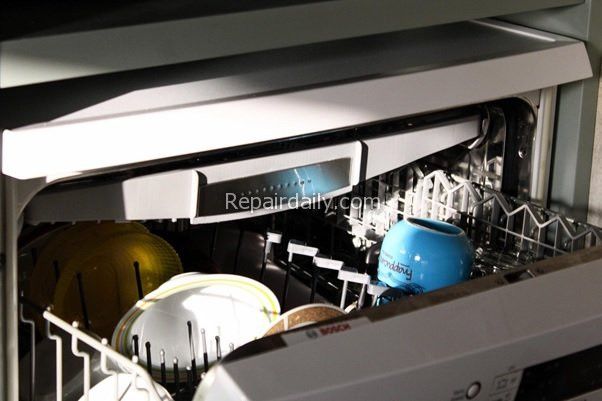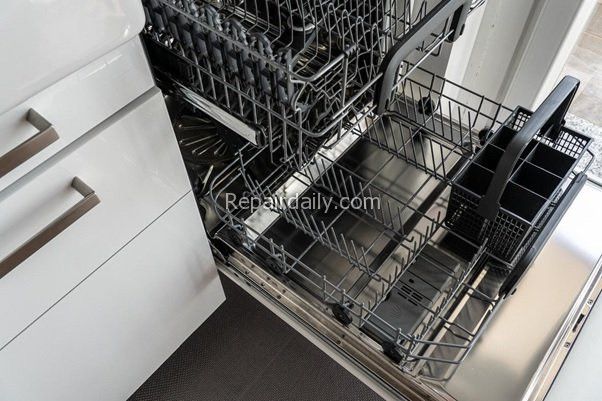
A dishwasher that refuses to fill with water can be incredibly frustrating, especially when you rely on it to keep your kitchen clean. Fortunately, you don’t need a plumber to diagnose and fix most issues. However, you may need professional plumber help if you notice water leaking from beneath the dishwasher, hear unusual buzzing or grinding noises, or experience electrical malfunctions such as flickering lights or a tripped breaker.
On the other hand, common DIY fixes include checking the water supply, cleaning clogged filters, inspecting the float switch, testing the dishwasher flow control valve, and ensuring the door latch is functioning properly. Whether you have a KitchenAid or another brand, this guide will walk you through the common causes and solutions for a dishwasher not getting water. Follow these troubleshooting steps, and you’ll have your dishwasher up and running in no time.
Common Causes of a Dishwasher Not Filling with Water
Before we dive into specific troubleshooting steps, it’s important to understand the common reasons why a dishwasher has no water. A disconnected or kinked water supply line can prevent the dishwasher from filling with water. The dishwasher flow control valve can become clogged, restricting water entry. A float switch stuck in the “up” position may cause the dishwasher to think it’s already full, preventing it from taking in more water. If the door switch is defective, the dishwasher may not register that the door is securely closed, halting the filling process. Clogged filters or spray arms can lead to improper water distribution and a faulty water inlet valve can stop water from entering the unit altogether.
Step-by-Step Troubleshooting Guide
Follow these steps to troubleshoot and fix a dishwasher not working due to a lack of water.
Step 1: Check the Water Supply
The first step is to ensure that your dishwasher is receiving water from the supply line. Locate the shutoff valve under your sink and make sure it is fully open. Examine the water hose for any kinks or blockages, straightening or replacing it if necessary. Additionally, test the water pressure in other appliances to determine if a broader plumbing issue exists in your home.
Step 2: Inspect the Dishwasher Flow Control Valve
The dishwasher flow control valve regulates the amount of water entering the unit. If it’s clogged, the dishwasher won’t fill properly. To test it, first, turn off the power and water supply to the dishwasher. Remove the lower front panel to locate the valve, then inspect it for blockages caused by debris or mineral buildup. If the valve appears clean but still isn’t functioning, use a multimeter to check if it is receiving power. If not, replacing the valve may be necessary.
Step 3: Examine the Float Switch
The float switch prevents the dishwasher from overfilling with water. If it’s stuck in the “up” position, the dishwasher might mistakenly believe it’s already full and won’t allow more water in. Locate the float switch, which is typically a small plastic disk or dome inside the bottom of the dishwasher tub. Manually move the float up and down to ensure it moves freely, and remove any debris that could be interfering with its function.
Step 4: Check the Door Switch
A faulty door switch can prevent the dishwasher from detecting that the door is securely closed, which may stop it from filling with water. Try opening and closing the door firmly while listening for a clicking sound. Inspect the door latch to see if it is loose or broken, as this may require replacement. If you suspect the switch is faulty, use a multimeter to test for continuity. If no continuity is detected, replacing the switch should resolve the problem.
Step 5: Clean the Spray Arms and Filters
A clogged spray arm or filter can lead to improper water distribution, making it seem like there’s no water entering the dishwasher. Remove and rinse the spray arms, clearing out any blockages using a toothpick if necessary. Locate the filters at the bottom of the dishwasher and rinse them under warm water to remove debris. Running a cycle with a cup of white vinegar on the top rack can also help break down buildup inside the dishwasher.
Step 6: Replace the Water Inlet Valve
If all else fails, the water inlet valve may be malfunctioning and require replacement. To do this, first, turn off the power and water supply. Remove the lower access panel to access the valve, then disconnect the hoses and wiring. Install a new valve, reconnect the necessary components, and turn the power back on to test the dishwasher’s functionality.
Common Dishwasher Problems and Solutions

Why Is My Dishwasher Holding Water After the Cycle Ends?
If water is pooling at the bottom of your dishwasher after the cycle ends, the issue is likely related to drainage rather than water entry. A clogged drain hose could be preventing proper water flow, so remove it and flush it out with water to clear any obstructions. If your dishwasher drains through a garbage disposal, ensure that it is not blocked, as this can also cause water to back up into the dishwasher. Additionally, if you hear a humming sound but no water is draining, your drain pump may be malfunctioning and require replacement.
Why Is My Dishwasher Not Getting Water?
If your dishwasher is not receiving water, several potential causes need to be examined. The water supply valve may be closed, preventing water from flowing into the dishwasher. The water inlet valve could be clogged or defective, restricting the necessary water intake. A float switch stuck in the “up” position may trick the dishwasher into thinking it is already full, stopping additional water from entering. If the door switch is not functioning properly, the dishwasher might not register that the door is closed, preventing the cycle from starting. By following the troubleshooting steps outlined above, you should be able to pinpoint and resolve the issue.
Why Is My Dishwasher Not Working?
If your dishwasher is completely unresponsive, a few key areas should be checked. First, ensure that the dishwasher is plugged in and that the circuit breaker has not been tripped, as power loss could be the root cause. If the control board is malfunctioning, the buttons on the dishwasher may not respond, indicating that the control panel might need replacement. In cases where the motor has failed, the dishwasher may not start at all, necessitating professional assistance.

Get Your Dishwasher Running Again Today!
Fixing a dishwasher that is not filling with water is often simpler than it seems. By following these troubleshooting steps, you can resolve most issues without calling a plumber. Whether the problem is caused by a clogged filter, a stuck float switch, or a defective flow control valve, these DIY solutions should help restore your dishwasher’s functionality. However, if none of these fixes work, it may be time to consult a professional for further inspection.
I'm so excited to tackle all my home improvement projects! From plumbing to DIY and cleaning - I'm ready to get down to work! #homerepair #homecleaning #plumbing #diy #fixerupper #realestate #renovation #interiordesign #farmhouse #diy #homedecor #hgtv #home #farmhousedecor #modernfarmhouse #farmhousestyle #fixerupperstyle #fixandflip #homerenovation #realestateinvesting #beforeandafter #homesweethome #remodel #realestateinvestor #interior #realtor #joannagaines #flippinghouses #countryliving #design #homedesign #farmhouseinspired #investmentproperty #bhghome #renovationproject #farmhousekitchen #homeimprovement #farmhouseliving #cottagestyle #decor #realestateagent #magnoliahome #homeinspo #magnoliamarket #kitchendesign #dreamhome #shiplap #construction #houseflipping #investor #farmhousedesign #architecture #farmhousechic #homereno #rusticdecor #reno #kitchenremodel #webuyhouses #magnoliatable #rentalproperty #fixerupperinspired #newhome #interiors #homeremodel

